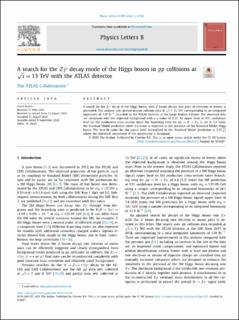A search for the Zγ decay mode of the Higgs boson in pp collisions at 1 √s=13 TeV with the ATLAS detector
Aad, Georges; Abbott, Brad; Abbott, Dale C.; Abed Abud, Adam; Abeling, Kira; Abhayasinghe, Deshan Kavishka; Abidi, Syed Haider; AbouZeid, Ossama Sherif Alexander; Abraham, Nadine L.; Abramowicz, Halina; Bjørke, Kristian; Bugge, Magnar Kopangen; Cameron, David Gordon; Catmore, James Richard; Garonne, Vincent; Gramstad, Eirik; Heggelund, Andreas Løkken; Hellesund, Simen; Håland, Even Simonsen; Morisbak, Vanja; Oppen, Henrik; Ould-Saada, Farid; Pedersen, Maiken; Read, Alexander Lincoln; Rye, Eli Bæverfjord; Røhne, Ole Myren; Sandaker, Heidi; Vadla, Knut Oddvar Høie; Buanes, Trygve; Djuvsland, Julia Isabell; Eigen, Gerald; Fomin, Nikolai; Lee, Graham Richard; Lipniacka, Anna; Martin dit Latour, Bertrand; Stugu, Bjarne; Træet, Are Sivertsen; Abreu, Henso; Abulaiti, Yiming; Acharya, Bobby S.; Achkar, Baida; Adam, Lennart; Adam-Bourdarios, Claire; Adamczyk, Leszek; Adamek, Lukas; Adelman, Jareed; Adersberger, Michael; Adigüzel, Aytül; Adorni, Sofia; Adye, Tim; ATLAS, Collaboration
Journal article, Peer reviewed
Published version

Åpne
Permanent lenke
https://hdl.handle.net/11250/2753278Utgivelsesdato
2020-10-10Metadata
Vis full innførselSamlinger
Sammendrag
A search for the Zγ decay of the Higgs boson, with Z boson decays into pairs of electrons or muons is
presented. The analysis uses proton–proton collision data at √s = 13 TeV corresponding to an integrated
luminosity of 139 fb−1 recorded by the ATLAS detector at the Large Hadron Collider. The observed data
are consistent with the expected background with a p-value of 1.3%. An upper limit at 95% confidence
level on the production cross-section times the branching ratio for pp → H → Zγ is set at 3.6 times
the Standard Model prediction while 2.6 times is expected in the presence of the Standard Model Higgs
boson. The best-fit value for the signal yield normalised to the Standard Model prediction is 2.0+1.0−0.9
where the statistical component of the uncertainty is dominant.
